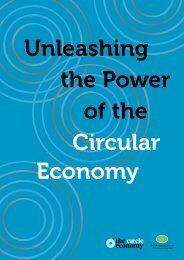ALIGNING PROFIT AND ENVIRONMENTAL SUSTAINABILITY: STORIES FROM INDUSTRY
ALIGNING PROFIT AND ENVIRONMENTAL SUSTAINABILITY: STORIES FROM INDUSTRY
ALIGNING PROFIT AND ENVIRONMENTAL SUSTAINABILITY: STORIES FROM INDUSTRY
You also want an ePaper? Increase the reach of your titles
YUMPU automatically turns print PDFs into web optimized ePapers that Google loves.
4. DEVELOPING METRICS TO ACCOUNT<br />
FOR EXTERNAL <strong>ENVIRONMENTAL</strong> COSTS<br />
Natura<br />
Founded in 1969, Natura is a Brazilian company and brand leader in cosmetics,<br />
fragrances, and personal care. Company revenues were BRL5.5 billion<br />
in 2011 (approximately US$3 billion). Natura operates in seven countries<br />
– Argentina, Brazil, Chile, Colombia, France, Mexico, and Peru – and has<br />
distribution of its products to four others: Bolivia, Guatemala, Honduras,<br />
and El Salvador. It has been listed on the São Paulo Stock Exchange since<br />
2004. The company does not have retail stores but instead sells its products<br />
through a network of almost 1.5 million resellers, the “Natura Consultants.”<br />
Natura accounts for its greenhouse gas (GHG) emissions using the GHG<br />
Protocol. It has established relative and absolute GHG emissions reduction<br />
targets for its scope 1 and 2 emissions and has set reduction targets for<br />
emissions from its products (which are part of scope 3). 34 Natura has a Climate<br />
Neutral Program in place, conducts life cycle assessments (LCA) of its<br />
products, and discloses environmental data about its products on packages.<br />
PROBLEM TO BE SOLVED<br />
In accordance with its commitment to sustainability, Natura wanted to find a way to<br />
drive environmental performance through its supply chain and engage its suppliers<br />
in a program aimed at improving their social and environmental contribution.<br />
STRATEGY<br />
Natura has established several focus areas for its overall sustainability<br />
program: water, sustainable entrepreneurship, climate change, solid waste,<br />
quality in relationships (sales force, society and communities, and increasing<br />
transparency and public participation), and socio-biodiversity in the Amazon<br />
region. Its supplier engagement program is called “Strategic Sourcing TBL”<br />
and was developed in partnership with the management consulting firm A. T.<br />
Kearney. The program aims to account for suppliers’<br />
18 |<br />
economic costs (prices);<br />
CO 2 emissions;<br />
waste generation;<br />
water used;<br />
employee education (investment amounts in lower and higher education);<br />
employee training (hours of training);<br />
work safety (accident rates);<br />
social inclusion (hiring rates of disabled people, compensation values,<br />
and hiring of apprentices);<br />
direct investment in society (for example, in the communities in which<br />
suppliers are based, on health, education, environment, and so on); and<br />
other social benefits.<br />
The performance of suppliers in these areas is quantified and included as<br />
part of the “Supplier Development Program.” It also allows Natura and suppliers<br />
to establish common strategies to improve suppliers’ performance with<br />
a “triple bottom line” (TBL) approach.<br />
On a quarterly basis, suppliers complete a questionnaire to account for and<br />
evaluate their socioenvironmental performance and progress. The results<br />
of the questionnaire are then used by Natura to measure and internalize the<br />
various socioenvironmental costs and benefits to society of the materials<br />
used by Natura. Natura bases its supplier selection on a “shadow price” that<br />
includes the price provided by suppliers as well as the socioenvironmental<br />
costs and benefits determined from the quarterly basis survey. As a result,<br />
Natura’s selection of suppliers is based on the overall total lowest cost,<br />
including the cost to society, which does not necessarily correspond to the<br />
lowest initial price of the suppliers’ product offerings. The assumed value<br />
of the suppliers’ socioenvironmental performance relates both to the part of<br />
the production sold to Natura and to the overall production of the supplier,<br />
ensuring that suppliers are recognized for taking a comprehensive approach<br />
to social and environmental performance.<br />
Evaluation of suppliers by Natura is undertaken annually by a multidisciplinary<br />
team. The project quantified a value for each externality in order to<br />
address questions such as “How much does a ton of CO 2 emitted cost in<br />
terms of environmental damage or public health costs?”; “What is the social<br />
value of one year of education for a given individual?”; “How much does the<br />
society gain when a disabled person is employed?” The figures were based<br />
on assumptions and studies currently available.<br />
RESULTS<br />
The Strategic Sourcing TBL program was launched by Natura in 2010.<br />
Initially as a pilot, it engaged 50 of the largest suppliers in the company’s<br />
supply chain. These suppliers were trained in Natura’s methodology and<br />
were assisted in data collection. Some data was not available and some<br />
had never been measured by the suppliers. Currently the program includes<br />
110 suppliers that represent approximately 50 percent of the total supply<br />
chain spending. Natura plans to increase supplier participation levels<br />
over time. Each supplier is assessed on specific issues it should focus on,<br />
based on its response to the questionnaire used by Natura. Performance<br />
is again measured in the following period. The company estimates that the<br />
socioenvironmental benefits of picking suppliers who are high sustainability<br />
performers was worth over BRL$500,000 in 2011 (more than US$250,000),<br />
BRL$1.8 million in 2012 and expects it to be over BRL$1.9 million (more<br />
than US$900,000) per year over the next four years.



